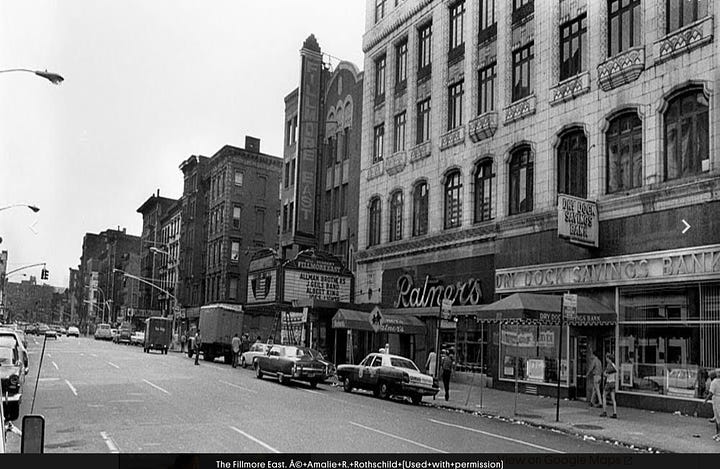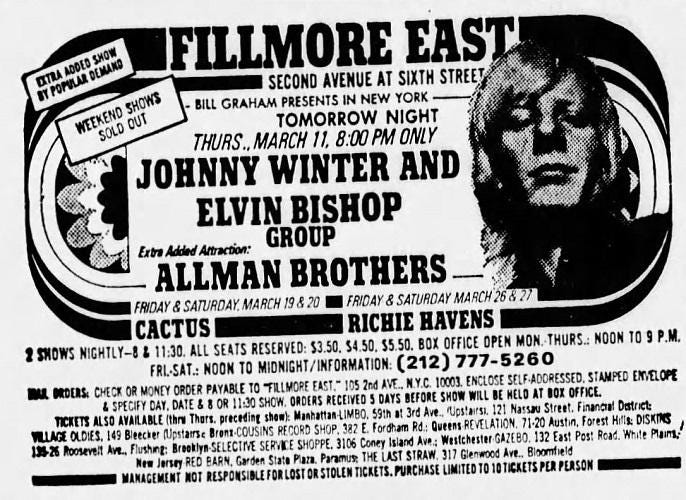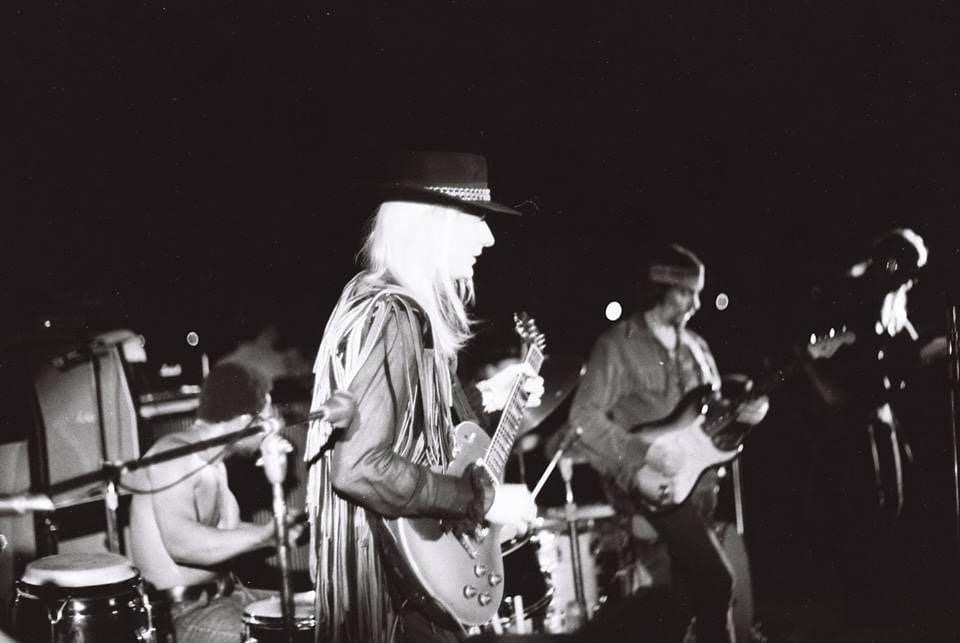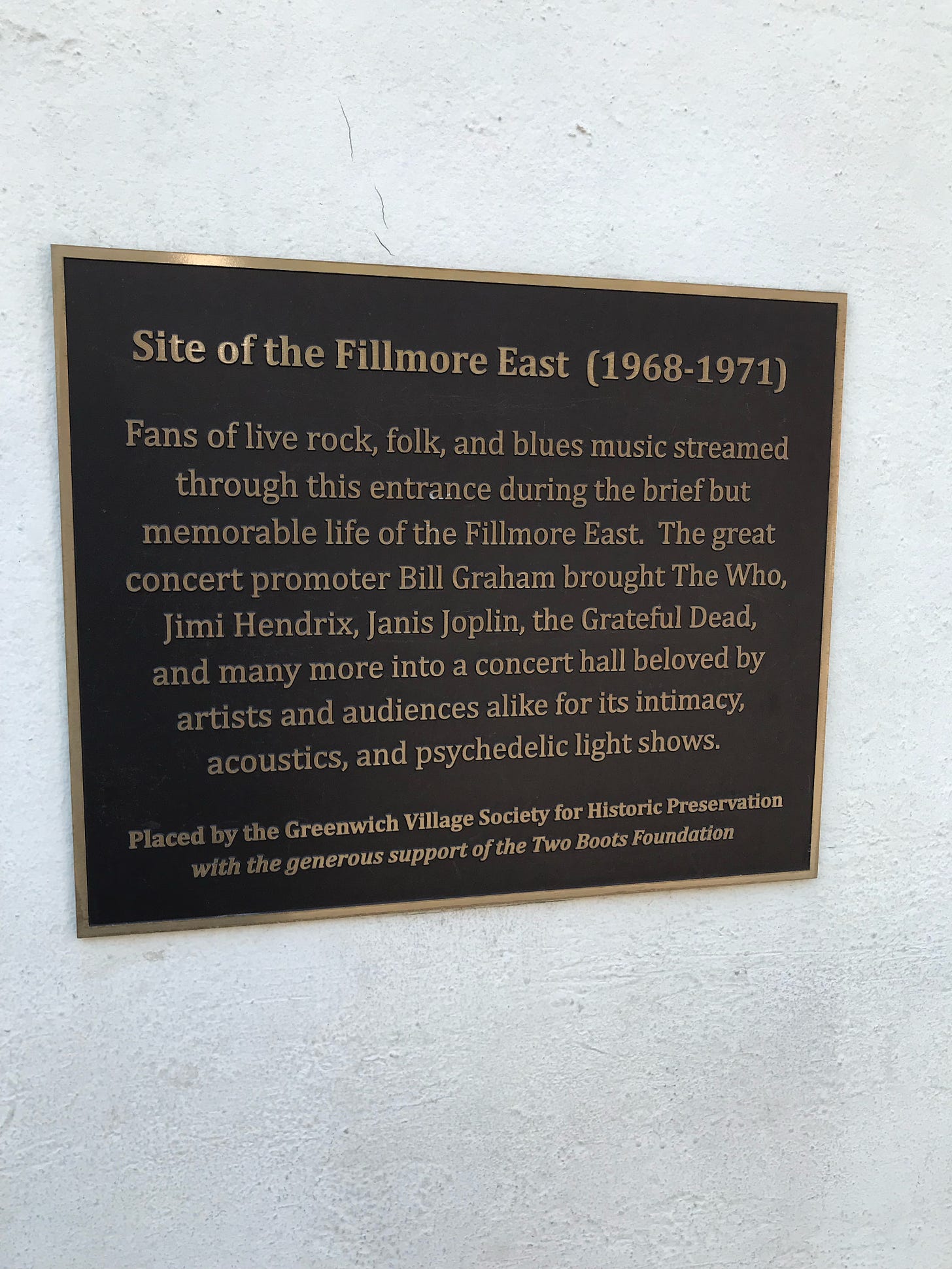Which version of At Fillmore East?
At Fillmore East as an artistic statement (part 1 of who knows how many?)
There are 255 international and 114 U.S. versions of At Fillmore East listed on Discogs. In addition, the band and its various record labels have rereleased the album in various formats including 1992’s The Fillmore Concerts (more on that below) and 2014’s The 1971 Fillmore East Recordings.
Which do I recommend when reading Play All Night! Duane Allman and the Journey to Fillmore East


🍄 Original 7-song album released in 1971
Youtube At Fillmore East playlist
Spotify
OR
🍄 At Fillmore East, Play All Night! edition
with “Mountain Jam” tacked on to the end of “Whipping Post” (as God and Duane intended) and “Little Martha” from Eat a Peach.
Some Context for At Fillmore East
Play All Night! details about why At Fillmore East was so crucial to the Allman Brothers Band. Bottom line, it was the band’s make-or-break 3rd album. They were several hundred thousand dollars in debt to their record label and manager, who couldn’t recoup their losses because their first two albums sold less than 150,000 combined units.
They toured relentlessly, earning a reputation as a must-see band. They knew they played better in front of an audience. Recording live was their only option.
The decision to record live was a huge gamble because of how unusual it was to have a major hit with a live album. No artist from the rock underground had done so.
The Venue
Bill Graham’s Fillmore East was at 6th Street and 2nd Avenue in the heart of New York City’s East Village. A narrow lobby at 105 2nd Avenue opened into a 2,600-seat room built in 1925-6 as a Yiddish theater in the Medieval Revival style.
Graham opened Fillmore East on March 8, 1968. A little more than three years later, on June 27, 1971, the Allman Brothers played the venue’s final show. The building changed hands several times over the years. From 1980-88 it was the famous gay nightclub The Saint.
The building fell into disrepair was demolished in 1996. Today, there is an exhibit inside the original lobby, now a bank. A plaque outside makes no mention of the ABB’s most important album.1


The Bill
The Allman Brothers were the scheduled middle act on a bill that included Elvin Bishop opening and Johnny Winter And closing. By the second night, they were the closing act.
There are a lot of serendipitous moments with this album.
For example, Elvin Bishop played on the Paul Butterfield Blues Band’s recording of “Spoonful,” which Duane copped for the Allman Joy’s 1966 recording, their first single.
Tom Dowd, their producer, wasn’t supposed to be in town, but a snowstorm in Paris brought home from Africa early(!). Grateful for that on a number of fronts, his brilliant engineering on the live sessions, but also convincing Duane to abandon the Juicy Carter experiment.
But it’s the Johnny Winter connection that really stands out to me.
Winter served as Duane’s foil and observers had long compared the two white, southern, slide guitarists. It puzzles me that Liberty Records handled national distribution for Winter’s first album at the same time Duane struggled mightily to get the label to pay attention to his interpretation of the blues. (They also had Canned Heat!)

In January 1969, shortly before he formed the Allman Brothers Band, Duane told fellow Muscle Shoals guitarist Jimmy Johnson (of the Swampers),
“Johnny is really good, but I can cut him. You see that stage down there? Next year by this time, I’m going to be down there.”
Duane made good on his boast the following December. It was the beginning of an enduring friendship between the band and Bill Graham, including playing the venue’s closing sets (listen to Graham speak about that gig).
Winter sat in with the Allman Brothers Band a few times over the years including at the March 1970 Winter’s End Festival in Bithlo, Florida (below). His appearance on “Mountain Jam” at the 2nd Atlanta Pop Festival in July 1970 has been officially released.
Each band was to play six shows over three nights: Thursday, March 11, Friday, March 12, and Saturday March 13, 1971. The Allman Brothers planned to record four shows, the early and late shows March 12 and 13. (Best I can tell, March 11 was a rehearsal run that wasn’t recorded or they taped over.2)
After night one, Johnny Winter demanded to switch places.
“The Allman Brothers tore into the early show like it was a Friday night late show,” Alan Arkush recalled. The energy stunned the headliner. “He just couldn’t top them.” Winter demanded to switch places.
“Johnny is gonna be opening for the Allman Brothers from now on because we can’t have that happen again,” said his manager. Winter played the middle slot for rest of the run.
The lineup change gave the ABB the time and liberty to do what it did best, improvise and expand songs as the muse struck. Graham’s bills afforded only ninety minutes to the middle act, not enough time for a band that topped a combined sixty minutes with only four songs on At Fillmore East: “You Don’t Love Me” (19:06), “Whipping Post” (22:40), “In Memory of Elizabeth Reed” (12:46), and “Stormy Monday” (8:31).
I’m a huge fan of Johnny Winter’s work, but he’s not the first artist the ABB blew off the stage. In this case, I’m thankful his management recognized it.
The Set
I’ll focus on just the At Fillmore East tracks here and do a deep dive on the full sessions at a later date.
Statesboro Blues (3/13, early show). The song that inspired Duane to learn slide was in the ABB repertoire from the beginning. The ABB play Taj Mahal’s arrangement of Blind Willie McTell’s original, a version they’d been tweaking since their earliest days.
Done Somebody Wrong (3/12, late show). Duane introduces this song as “An old, true story.” A quick look shows that these shows are the first time “DSW” appears on tape. The final (third) take is what made the album.
Stormy Monday (3/13, late show). The ABB nailed their only take of this blues standard, one they weren’t playing all that often at this point in their career.
You Don’t Love Me (3/13 early show; 3/12, late show). YDLM joined the repertoire in July 1970 and by this point, the band stretched it out to nearly 20 minutes. (At 16:17-18 is the famous “Play all night!”)
Hot ‘Lanta (3/13, late show). An instrumental credited to the entire band, the group debuted it in early 1971.
In Memory of Elizabeth Reed (3/13, early show). It goes against my every instinct to call anything perfection, but this is perfection in musical form. One of two previously released songs.
Whipping Post (3/13, late show). The second previously released song, and ditto above. The Allman Brothers Band at their ABBsolute finest.
Song Statistics:
The album has three originals, “Hot ‘Lanta” (credited to the whole band), “In Memory of Elizabeth Reed” (Dickey Betts), and “Whipping Post” (Gregg Allman).
All four covers are blues songs. “Statesboro” Blind Willie McTell by way of Taj Mahal; Elmore James’s “DSW;” “Stormy Monday” T-Bone Walker by way of Bobby Bland; and “YDLM” from Junior Wells (with Buddy Guy) Hoodoo Man Blues.
The oldest in the repertoire is “Statesboro Blues,” which the band had tried to record as recently as a year before on Idlewild South. “Done Somebody Wrong” is the newest. Unless I’m mistaken, it had its debut at Fillmore East.
Two tracks, “Liz Reed” and “Whipping Post,” had appeared on previous albums. The other five tracks are new.
Though the band never recorded a studio version, “Hot ‘Lanta” was the only song that made the setlist of the solo efforts of each surviving bandmember.
General Thoughts
First, I wrote an entire book about this album, so I’ll direct you to Play All Night! for more information.
Here are some thoughts as you listen:
Every single note is improvised. Every.single.note. And not one is corrected in post-production. If you want to hear what I mean, check out The 1971 Fillmore East Recordings to see how the tracks evolved over the weekend.
At Fillmore East is not a concert. Like most live albums it is a carefully curated document pulled from various performances over the weekend.
There is not a single overdub on the record. There are, however, two edits: Thom Doucette’s harmonica solo was cut from “Stormy Monday” and “You Don’t Love Me” is a splice of two versions.
At Fillmore East is non-traditional for a live rock album in that it is not mixed as if the record is a concert. Each track fades out before a new song plays.
The fade-outs have long baffled me because I know of no other live rock album that’s like this. Records released in this time period all sound like a concert. I’ll name some pretty famous live records from the ABB’s contemporaries:
Grateful Dead - Live/Dead 1969
Jefferson Airplane - Bless Its Pointed Little Head 1969
Jimi Hendrix - Band of Gypsys 1970
The Doors - Absolutely Live 1970
The Rolling Stones - Get Yer Ya Ya’s Out 1970
The Who - Live at Leeds 1970
Joe Cocker - Mad Dogs and Englishmen 1971
Every record above comprises multiple concerts, and every record sounds like a single show. For those of us who couldn’t get to a Rolling Stones show on the 1969 tour, Get Yer Ya Ya’s Out is the next best thing to being there. That’s true about every other album on this list.
So why the fade-outs? Best I can come up with (and yes, I’ve thought about this A LOT) is that the band wanted the songs treated as individual songs, such as on a studio record, rather than as part of a hypothetical “concert.”
Everything was riding on the success of At Fillmore East. This was the group’s definitive artistic statement. One they made on their own terms, which is true to form for the Allman Brothers Band.
It paid off, and the album went gold October 25, 1971. Sadly, four days later, Duane Allman died in a motorcycle accident. He didn’t live to see the success of his crowning artistic achievement.
Final Thoughts
I really dig the between-song banter. Every song but “Hot ‘Lanta” has something either before or after the song. It reflects the band’s good nature. Duane calls out other artists—Elmore James, Bobby “Blue” Bland, and T-Bone Walker—and introduces “Liz Reed” as “Dickey Betts’s song.” Berry exclaims “Brother Gregg Allman sings the blues!” after “Stormy Monday.” As Duane introduces says “Berry starts ‘er off,” listen closely and you’ll hear 5 people yell out “Whipping Post.”
I love Fillmore East stage manager Michael Ahren’s deadpan intro, ”Okay, the Allman Brothers Band” that kicks off the album. The band is about to play its 5th show of the run and they come out FIRING.
My first experience with this album was on a cassette I got far too early in my life—you can read about it here
After my “conversion” to the ABB, I picked up The Fillmore Concerts, a 1992 release that created an Allman Brothers Band live album that effectively recreated a 1971 Allman Brothers show. It is magnificent for that very reason and also because it put “Whipping Post” and “Mountain Jam” together for the first time in the cd era.
Despite what The Fillmore Concerts (1992) liner notes say, Tom Dowd DID NOT splice two different versions of “In Memory of Elizabeth Reed” together. Per Kirk West, the ABB’s long-time archivist/Tour Mystic, also a co-producer on the set, Dowd conflated two separate mixes as two separate tracks. This confirms what I’ve heard with my own ears: I’ve listened closely and never heard anything different in the notes/playing.
Here’s the playlist I jammed while writing Play All Night!: At Fillmore East plus “Mountain Jam”—because then the record sounds incomplete to me without this pairing.
The ABB continued to fade tracks in/out on live albums through the 1990s, finally dropping the habit with 2000’s Peakin’ at the Beacon and 2004’s One Way Out.
Berry Oakley mentions recording four shows in the stage banter on 3/20/71 at the Warehouse in New ORLEANS.







I love that you've done this, taken this on...especially for the young people who don't have the context and life experience of 1971, who are "discovering" this music for the first time...and it is "timeless" music and musicianship. As fresh today as it was in 1971. I was fortunate to be playing in a band with 3 brothers in the summer of 1971 when Fillmore was released. We had played our first gig as a trio that winter and then added 2 horn players (including the 3rd brother who was only 15). We were already playing some Allman material when Live came out...and that experience of the live album altered our playing and understanding of that band. We were blown away.... we had never heard a band like that. From that point on, for the next 3 years we started most nights with Statesboro and finished with Whipping Post. We were the band in our region around Hagerstown MD, just south of the Mason Dixon line...playing dives, VFWs, school dances, college gigs along Rt 40 and Rt 11 covering the Allman Bros. and other Capricorn acts, like Marshall Tucker...(we had the flute) and Wet Willie. We covered Johnny & Edgar Winter...BB King and also did Bay area horn bands like Tower of Power, Clod Blood and Santana with some Zappa thrown in. It was VERY cool for an 18 year old who had just graduated high school. Sadly we did not get to the Painters Mill gig. We never experienced Duane live. Our first big concert experience was at the Baltimore Civic Center in 1972, with the 5 piece band. At least we got to see & hear Berry...and BB King was the opening act...so he played 2nd guitar on a few tunes with Dickey. Fast forward to today and I'm now making a documentary focused on Butch's relationship with Duane and the band camp he created called Roots Rock Revival. The children of Butch, Dickey, Berry, and Lamar all participate in the camp along with Oteil who helped Butch create it. Jaimoe has attended. This road does go on forever. What's happening now is the 2nd & 3rd generations keeping the music alive and fresh and generating, mentoring new artists who appreciate these roots, who want to be working musicians...artists.
Thanks for your work and this forum.
>>The fade-outs have long baffled me because I know of no other live rock album that’s like this.<<
I'm pretty sure that the Dead's "Europe '72" LP is that way, and possibly some other subsequent live Dead LPs.
But no matter, I enjoyed your great piece on a great album - my first exposure was a pink-label stock copy bought at Korvette's back in 1972 or so, then in later years working in a used record store I was lucky enough to get a white-label promo copy which I still have. Worth a small fortune in the Discogs.com era.
"The Fillmore Concerts" CD box that came out in the '90s (?) was a must-have (I was excited about the color version of the famous cover photo!), but when the 'complete' (really only partly complete) set came out a few years ago I snapped that up and was amazed to learn about the whole Juicy Carter story and hear those songs with horns - fascinating and cool in way, but thank God Tom Dowd nixed that plan for the final LP!
"Fillmore East" is truly one of the greatest albums in rock history, possibly the greatest live rock album ever.
Having played it 10 million times or so, however, I have to admit that my go-to these days is the Atlanta Pop Festival 1970 recordings that came out officially quite a few years ago. Not as smooth as Fillmore East recorded a few months later, but damn what an inspired and exciting performance - with "Dreams" and "Every Hungry Woman" in particular just *killing* me every time I hear them.